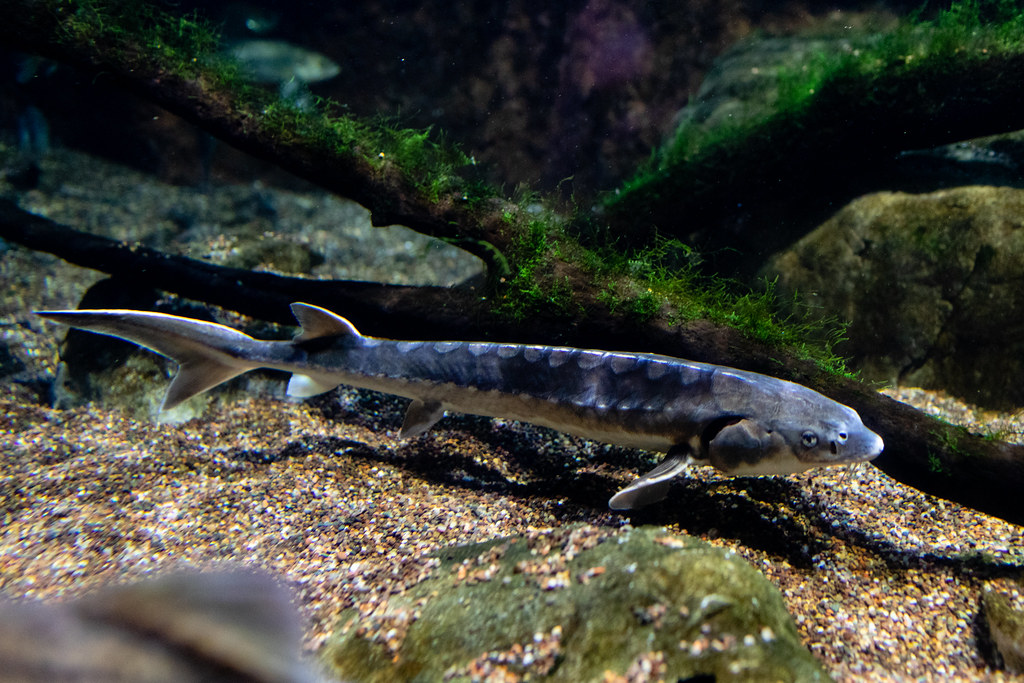Shortnose Sturgeon
Acipenser brevirostrum
The shortnose sturgeon is a bony, ancient-looking fish that lives mostly in the Potomac and Susquehanna rivers. It is an endangered species.
This section shows one large critter image at a time. Use the thumbnails that follow to select a specific image to display here.

This gallery contains a grid of small thumbnails. Selecting a thumbnail will change the main image in the preceding section.
Appearance
The shortnose sturgeon is an extremely rare fish that has a brown, tan or bluish-black body and a whitish belly. It has no scales, but five rows of bony plates, called scutes, cover its head and body: one along the back, one along either side and two along the belly. It grows very slowly, eventually reaching about 4.5 feet in length and weighing 50 pounds. It has a short, broad snout with a rounded tip, with four sensory barbels (whiskerlike organs) on the underside of its snout. Its mouth is soft and toothless.
Feeding
Shortnose sturgeon prey upon benthic creatures (organisms that live at the bottom) including clams and other mollusks, crustaceans, worms and insects. As bottom-feeders, they use their snout to root through the mud and find their prey, then suck it into their mouth like a vacuum.
Predators
Because of the bony plates covering its body, the shortnose sturgeon has few natural predators. Human activities such as pollution, historic overfishing and damming of rivers threaten sturgeons.
Reproduction and life cycle
Sturgeons are anadromous, meaning they live in the ocean and spawn in freshwater rivers. Spawning occurs from February to April in the fast-flowing freshwater river the fish was born in. Females lay anywhere from 27,000 to 208,000 eggs over an area with a rocky bottom.
Once hatched, the tadpole-like larvae remain in sheltered areas for about two weeks before being slowly carried downstream to merge with adults. By the time they are just an inch long, juveniles begin to resemble and act like adults. Sturgeon are very sensitive to low oxygen, pollution and other poor water conditions. This, combined with their slow rate of maturity, damming of their spawning rivers and historic commercial fishing pressure, has caused the species to become very rare.
Males do not reach sexual maturity until they are 3 to 5 years old. Females take 6 to 7 years to mature. Males can live to 30 years, while females can live more than 60 years.
Did you know?
- Sturgeon are prehistoric fish that have existed for more than 120 million years. They were around during the Cretaceous period, when dinosaurs roamed the earth.
- Sturgeon are the largest fish native to the Chesapeake Bay, although the shortnose sturgeon is the smallest sturgeon species.
- Sturgeon were abundant when English settlers arrived in the Bay region in the 1600s.They were a reliable source of food for the settlers most of the year.
- Sturgeon supported an important fishing industry from colonial times to the early 20th century. In particular, caviar from sturgeon eggs was considered a delicacy in Europe.
- The U.S. Fish and Wildlife Service classified the shortnose sturgeon as an endangered species in 1967. This means they cannot be legally caught for any purpose.
Sources and additional information
- Fishes of Chesapeake Bay by Edward O. Murdy, Ray S. Birdsong and John A. Musick
- The Virtual Aquarium: Shortnose Sturgeon – Virginia Tech
- Shortnose Sturgeon – Maryland Department of Natural Resources
